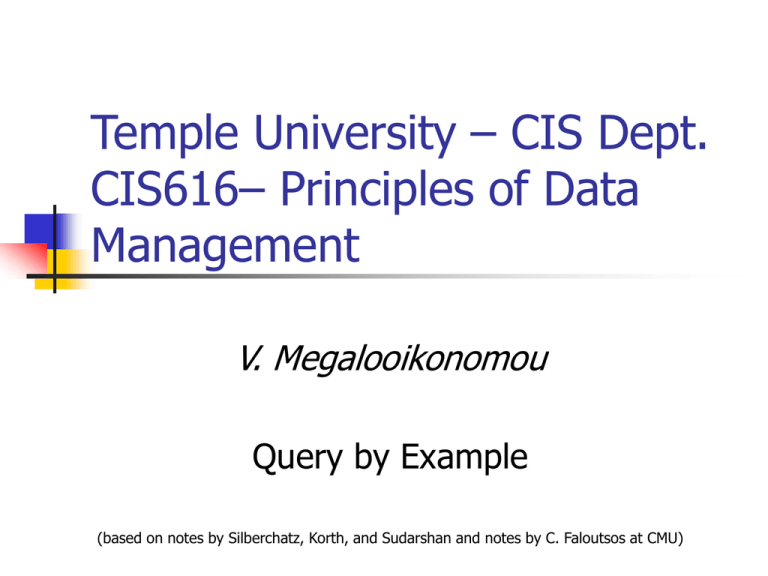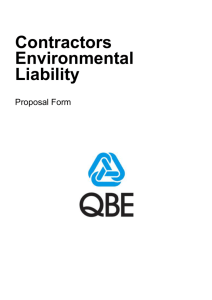Query by Example (QBE)
advertisement

Temple University – CIS Dept. CIS616– Principles of Data Management V. Megalooikonomou Query by Example (based on notes by Silberchatz, Korth, and Sudarshan and notes by C. Faloutsos at CMU) General Overview - rel. model Formal query languages rel algebra and calculi Commercial query languages SQL Query-by-Example (QBE) QUEL Query-by-Example (QBE) Basic Structure Queries on One Relation Queries on Several Relations The Condition Box The Result Relation Ordering the Display of Tuples Aggregate Operations Modification of the Database QBE — Basic Structure A graphical query language which is based (roughly) on the domain relational calculus Two dimensional syntax – system creates templates of relations that are requested by users Queries are expressed “by example” QBE Skeleton Tables for the Bank Example QBE Skeleton Tables (Cont.) Queries on One Relation Find all loan numbers at the Perryridge branch • • • • _x is a variable (optional; can be omitted in above query) P. means print (display) duplicates are removed by default To retain duplicates use P.ALL Queries on One Relation (Cont.) Display full details of all loans Method 1: P._x Method 2: Shorthand notation P._y P._z Queries on One Relation (Cont.) Find the loan number of all loans with a loan amount of more than $700 Find names of all branches that are not located in Brooklyn Queries on One Relation (Cont.) Find the loan numbers of all loans made jointly to Smith and Jones. Find all customers who live in the same city as Jones Queries on Several Relations Find the names of all customers who have a loan from the Perryridge branch Queries on Several Relations (Cont.) Find the names of all customers who have both an account and a loan at the bank Negation in QBE Find the names of all customers who have an account at the bank, but do not have a loan from the bank ¬ means “there does not exist” Negation in QBE (Cont.) Find all customers who have at least two accounts ¬ means “not equal to” The Condition Box Allows the expression of constraints on domain variables that are either inconvenient or impossible to express within the skeleton tables Complex conditions can be used in condition boxes E.g. Find the loan numbers of all loans made to Smith, to Jones, or to both jointly Condition Box (Cont.) QBE supports an interesting syntax for expressing alternative values Condition Box (Cont.) Find all account numbers with a balance between $1,300 and $1,500 Find all account numbers with a balance between $1,300 and $2,000 but not exactly $1,500 Condition Box (Cont.) Find all branches that have assets greater than those of at least one branch located in Brooklyn The Result Relation Find the customer-name, account-number, and balance for all customers who have an account at the Perryridge branch We need to: Join depositor and account Project customer-name, account-number and balance To accomplish this we: Create a skeleton table, called result, with attributes customer-name, account-number, and balance Write the query The Result Relation (Cont.) The resulting query is: Ordering the Display of Tuples AO = ascending order; DO = descending order. E.g. list in ascending alphabetical order all customers who have an account at the bank When sorting on multiple attributes, the sorting order is specified by including with each sort operator (AO or DO) an integer surrounded by parentheses. E.g. List all account numbers at the Perryridge branch in ascending alphabetic order with their respective account balances in descending order. Aggregate Operations aggregate operators: AVG, MAX, MIN, SUM, CNT these operators must be postfixed with “ALL” (e.g., SUM.ALL.or AVG.ALL._x) so that duplicates are NOT eliminated e.g.: find the total balance of all the accounts maintained at the Perryridge branch Aggregate Operations (Cont.) UNQ is used to specify that we want to eliminate duplicates find the total number of customers having an account at the bank Query Examples Find the average balance at each branch The “G” in “P.G” is analogous to SQL’s group by construct The “ALL” in the “P.AVG.ALL” ensures that all balances are considered To find the average account balance at only those branches where the average account balance is more than $1,200, add the condition box: Query Example Find all customers who have an account at all branches located in Brooklyn Approach: for each customer, find the number of branches in Brooklyn at which they have accounts, and compare with total number of branches in Brooklyn QBE does not provide subquery functionality both above tasks have to be combined in a single query Can be done for this query, but there are queries that require subqueries and cannot be expressed in QBE Query Example (Cont.) CNT.UNQ._w : number of distinct branches in Brooklyn Note: Variable _w is not connected to other variables in the query CNT.UNQ._z: number of distinct branches in Brooklyn at which customer x has an account Modification of the Database – Deletion Deletion of tuples: use of a D. command. In the case where we delete information in only some of the columns, null values, specified by –, are inserted Delete customer Smith Delete the branch-city value of the branch whose name is “Perryridge” Deletion Query Examples Delete all loans with a loan amount between $1300 and $1500 For consistency, delete information from loan and borrower tables Deletion Query Examples (Cont.) Delete all accounts at branches located in Brooklyn Modification of the Database – Insertion Insertion: place the I. operator in the query expression e.g., Insert the fact that account A-9732 at the Perryridge branch has a balance of $700 Modification of the Database – Insertion (Cont.) Provide as a gift for all loan customers of the Perryridge branch, a new $200 savings account for every loan account they have, with the loan number serving as the account number for the new savings account. Modification of the Database – Updates Use the U. operator to change a value in a tuple without changing all values in the tuple. QBE does not allow users to update the primary key fields Update the asset value of the Perryridge branch to $10,000,000 Increase all balances by 5 percent Microsoft Access QBE Microsoft Access supports a variant of QBE called Graphical Query By Example (GQBE) GQBE differs from QBE in the following ways Attributes of relations are listed vertically, one below the other, instead of horizontally Instead of using variables, lines (links) between attributes are used to specify that their values should be the same. Links are added automatically on the basis of attribute name, and the user can then add or delete links By default, a link specifies an inner join, but can be modified to specify outer joins. Conditions, values to be printed, as well as group by attributes are all specified together in a box called the design grid An Example Query in Microsoft Access QBE Example query: Find the customer-name, account-number and balance for all accounts at the Perryridge branch An Aggregation Query in Access QBE Find the name, street and city of all customers who have more than one account at the bank Aggregation in Access QBE The row labeled Total specifies which attributes are group by attributes which attributes are to be aggregated upon (and the aggregate function). For attributes that are neither group by nor aggregated, we can still specify conditions by selecting where in the Total row and listing the conditions below As in SQL, if “group by” is used, only “group by” attributes and aggregate results can be output General Overview Formal query languages Commercial query languages rel algebra and calculi SQL QBE, (QUEL) Integrity constraints Functional Dependencies Normalization - ‘good’ DB design










